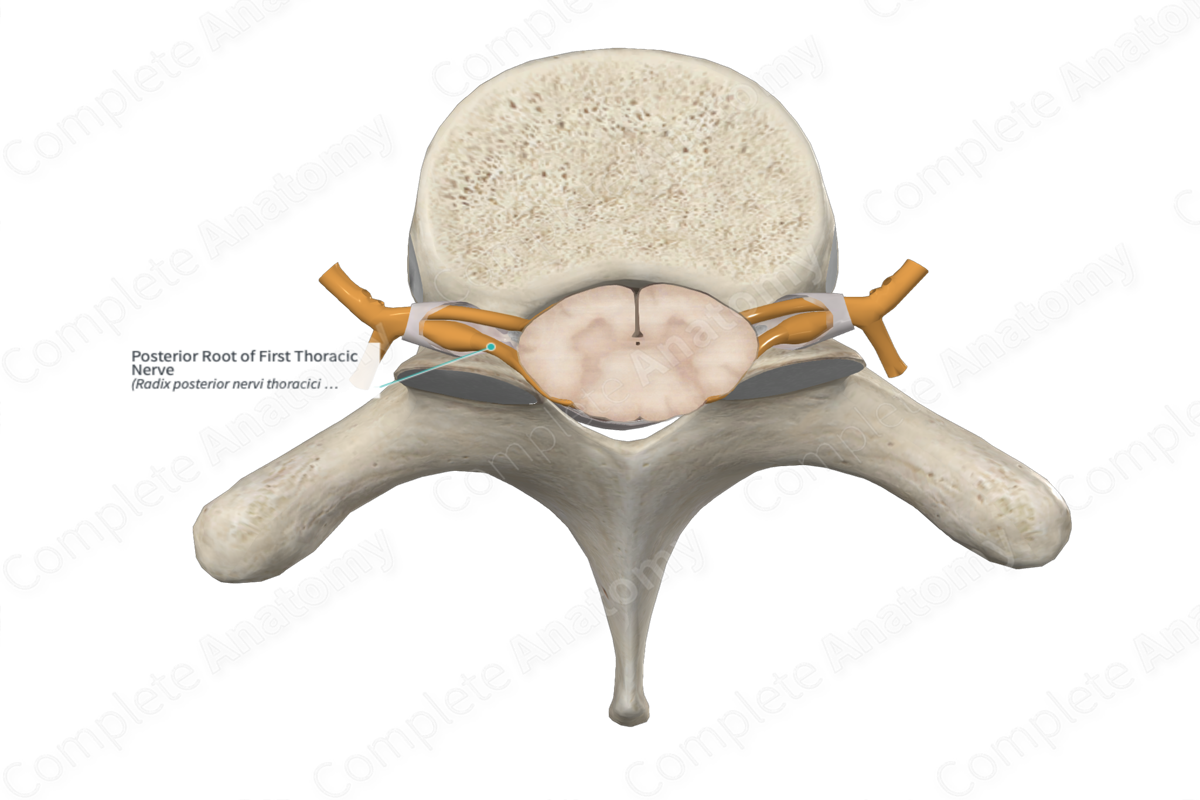
Posterior Root of First Thoracic Nerve
Radix posterior nervi thoracici primae
Read moreQuick Facts
Origin: First thoracic nerve.
Course: Medially towards the posterior side of the spinal cord.
Branches: None.
Supply: Sensory innervation from the upper trunk, medial arm and forearm, and axilla.
Related parts of the anatomy
Origin
The posterior root of the first thoracic nerve originates just lateral to or in the intervertebral foramen, between the first and second thoracic vertebrae. This corresponds to the point where the thoracic nerve splits into anterior and posterior roots.
Course
The posterior root of the first thoracic nerve runs from the intervertebral foramen medially towards the posterior side of the spinal cord. Because the intervertebral foramen is significantly lower than the corresponding spinal cord level, the posterior root must also ascend within the vertebral column. Adjacent to the appropriate spinal cord level, the posterior root splits into smaller rootlets, which enter the posterior spinal cord in line with the dorsal horn of the gray matter.
Branches
There are no branches of the posterior root of the first thoracic nerve. The proximal end of the posterior root has a bulge called the spinal (or dorsal root) ganglion, which is the location of the neuronal cell bodies of the neurons that form the posterior root.
Supplied Structures & Function
The posterior root of the first thoracic nerve carries all afferents from the first thoracic nerve, both somatic and visceral, to the first thoracic spinal segment of the spinal cord.
General somatic afferents originate in the sensory receptors of the periphery and convey sensations such as pain, temperature, and touch from the skin. Stretch receptors in muscles also send information on stretch via general somatic afferents.
The somatic afferents pass from either the posterior ramus or the anterior ramus of the first thoracic nerve into the first thoracic nerve itself. As they reach the medial border of the thoracic nerve, they segregate from the outgoing efferents by branching off to form the posterior root of the first thoracic nerve.
The posterior ramus of the first thoracic spinal nerve conveys general somatic sense from the dorsal skin and epaxial muscles of the upper trunk to the posterior root of the first thoracic nerve.
The anterior ramus of the first thoracic nerve conveys general somatic sense from the skin over the medial arm and forearm, axilla, and thoracic wall to the posterior root of the first thoracic nerve. Sensations of stretch from the intercostal muscles of the first intercostal space, the upper limb, and pectoralis muscles also travel via the posterior root of the first thoracic nerve to the spinal cord.
General visceral afferents from the heart and lungs travel from the thoracic organs, through the stellate ganglion, and into the first thoracic nerve before segregating into the posterior root of the first thoracic nerve. These continue into the posterior horn of the first thoracic spinal segment of the spinal cord.
List of Clinical Correlates
—Referred pain
Learn more about this topic from other Elsevier products



